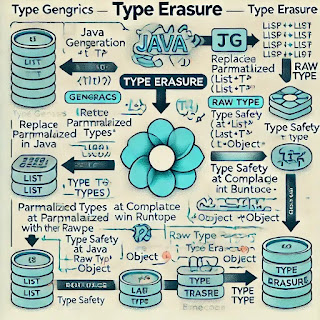Type Erasure in Java
Introduction
Type erasure is a fundamental concept in Java generics that ensures backward compatibility while maintaining type safety. Java introduced generics in JDK 1.5 to provide stronger type checks at compile time. However, Java uses a technique called "type erasure" to remove generic type information at runtime.
This article explains what type erasure is, why it is necessary, and how it affects Java programs.
What is Type Erasure?
Type erasure is the process where the Java compiler removes generic type information from code during compilation. This means that while generics help enforce type safety at compile time, the generated bytecode does not retain explicit information about generic types at runtime.
For example, consider the following generic class:
class Box<T> {
private T value;
public void set(T value) {
this.value = value;
}
public T get() {
return value;
}
}
At runtime, the above class will be transformed into:
class Box {
private Object value;
public void set(Object value) {
this.value = value;
}
public Object get() {
return value;
}
}
This means that the type parameter <T> is replaced with Object and all type information is erased.
Why is Type Erasure Needed?
1. Backward Compatibility
Java was initially designed without generics, so type erasure ensures that older non-generic code can still run with new generic classes without requiring changes to the JVM.
2. JVM Constraints
The Java Virtual Machine (JVM) does not natively support generic types. Instead of creating separate class files for each type parameter, Java compiles generics into a single class file, reducing class file bloat.
3. Performance Optimization
By erasing type parameters, Java avoids runtime overhead that would be associated with maintaining type information for generics.
Effects of Type Erasure
1. No Generic Type Information at Runtime
Since generics are erased, you cannot determine the actual type argument at runtime.
import java.util.ArrayList;
import java.util.List;
public class TypeErasureExample {
public static void main(String[] args) {
List<String> stringList = new ArrayList<>();
List<Integer> integerList = new ArrayList<>();
System.out.println(stringList.getClass() == integerList.getClass()); // true
}
}
Since both lists are treated as ArrayList<Object> at runtime, their classes are considered equal.
2. Cannot Create Generic Arrays
Due to type erasure, generic arrays are not allowed.
public class GenericArray<T> {
private T[] array;
public GenericArray(int size) {
// array = new T[size]; // Compilation error
}
}
Instead, we use workarounds like:
@SuppressWarnings("unchecked")
public GenericArray(int size) {
array = (T[]) new Object[size];
}
3. Type Casting is Required
Since generics are erased, Java often requires explicit type casting.
List<String> list = new ArrayList<>();
list.add("Hello");
String value = list.get(0); // No explicit cast needed
At runtime, this is equivalent to:
List list = new ArrayList();
list.add("Hello");
String value = (String) list.get(0); // Explicit cast required
4. Overloading Restrictions
Since generic type information is erased, methods with the same erased signature cannot be overloaded.
public class OverloadExample {
// Compilation error: Duplicate method
// public void print(List<String> list) {}
// public void print(List<Integer> list) {}
}
Both methods would be erased to print(List<Object>), causing a conflict.
Working Around Type Erasure
1. Using Reflection
Even though generic type information is erased, some metadata is retained in class files and can be accessed using reflection.
import java.lang.reflect.ParameterizedType;
import java.lang.reflect.Type;
import java.util.ArrayList;
public class ReflectionExample<T> {
public static void main(String[] args) {
ParameterizedType type = (ParameterizedType) new ArrayList<String>(){}.getClass().getGenericSuperclass();
Type[] typeArguments = type.getActualTypeArguments();
for (Type t : typeArguments) {
System.out.println(t.getTypeName());
}
}
}
2. Using Bounded Type Parameters
We can use bounded type parameters to restrict the kinds of objects that can be used with generics.
class NumericBox<T extends Number> {
private T value;
public NumericBox(T value) {
this.value = value;
}
public T getValue() {
return value;
}
}
Conclusion
Type erasure is an essential mechanism that allows Java to support generics without modifying the JVM. While it enforces type safety at compile time, it removes type information at runtime, leading to certain limitations. Understanding type erasure helps Java developers write better, more efficient, and error-free generic code.
By being aware of its effects and possible workarounds, developers can effectively use generics while minimizing potential pitfalls.
Do you have any questions or need further clarification? Let me know in the comments!
Sign up here with your email

ConversionConversion EmoticonEmoticon